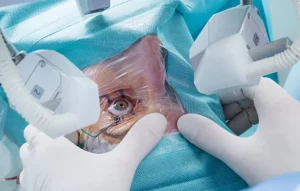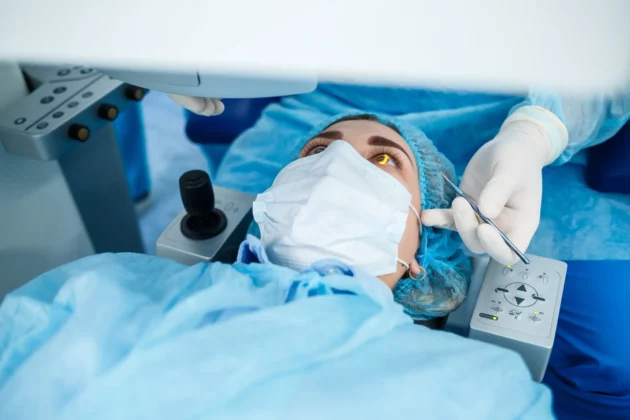Stepping into the unknown can often stir a whirlpool of doubts and fears, especially when it pertains to a procedure involving something as vital as our eyes. If you find yourself on the verge of undergoing a corneal transplant, you might be grappling with a flurry of questions, the most daunting of them all being, “Will it be painful?”
In this comprehensive guide, we aim to dispel myths, and most importantly, equip you with knowledge. Knowledge that demystifies the procedure, outlines pain management techniques, and ultimately, puts you at ease. So, take a deep breath as we unravel the reality of corneal transplant.
Contents
Understanding the Corneal Transplant Procedure
 Let us delve into the intricacies of what happens during this surgery, dispelling fears with facts and uncertainty with understanding.
Let us delve into the intricacies of what happens during this surgery, dispelling fears with facts and uncertainty with understanding.
A corneal transplant, also known as a corneal graft or keratoplasty, involves the replacement of a damaged or diseased cornea with a healthy one, usually sourced from a donor. This procedure has been a beacon of hope for many, promising restored vision and improved quality of life.
The surgery generally encompasses a few primary techniques, each tailored to address specific issues. These are:
- Penetrating Keratoplasty (PK): This traditional form involves the transplantation of a full-thickness donor cornea.
- Lamellar Keratoplasty: In this variant, only selective layers of the cornea are replaced, thereby reducing potential complications and fostering quicker recovery. This technique further divides into:
- Deep Anterior Lamellar Keratoplasty (DALK): Only the front layers are replaced, retaining the innermost layer.
- Endothelial Keratoplasty (EK): This focuses on replacing the inner layers of the cornea, with Descemet’s Stripping Endothelial Keratoplasty (DSEK) and Descemet’s Membrane Endothelial Keratoplasty (DMEK) being the popular methods.
Is Corneal Transplant Surgery Painful?
As you find yourself on the cusp of making a decision about corneal transplant surgery, one question might overshadow others: “Is the procedure painful?” It’s completely natural to harbor such concerns, given that surgery, to many, is synonymous with pain. However, we are here to assuage those fears by delving into why the surgery is not as painful as you might imagine.
Firstly, let’s unequivocally state that NO, the corneal transplant surgery is not painful. The foremost reason behind this is the proficient use of anesthesia during the procedure.
The Role of Anesthesia
Depending on the particulars of your case, you will be administered either local or general anesthesia. Local anesthesia works wonders in numbing the area surrounding the eyes, ensuring that you are insulated from any pain during the surgery. In cases where general anesthesia is employed, you would be in a state of controlled unconsciousness, completely detached from any sensations of pain.
Post-Operative Pain Management
Even after the surgery, the medical team remains steadfast in monitoring and managing any potential discomfort during the recovery phase. Though mild to moderate discomfort might be experienced post-surgery, it is well-managed through prescribed pain relievers, ensuring a smooth and comfortable recuperation journey.
Individual Pain Threshold
Furthermore, it’s essential to recognize that pain is a subjective entity, with variations in individual thresholds. Rest assured, the surgical team is adept at tailoring pain management strategies to align with each individual’s unique needs, thus paving the way for a largely pain-free experience.
Therefore, as you approach this significant step in reclaiming your vision, it’s comforting to know that your well-being and comfort are of paramount importance to the medical team. Feel free to communicate any concerns with your surgeon, fostering a relationship of trust and openness, which can indeed set a positive foundation for successful surgery and recovery.
Managing Pain After Surgery
 Embarking on your recovery journey a corneal transplant surgery, you might wonder about the ways to effectively manage pain and ensure a smooth transition back to normalcy. While the corneal transplant procedure itself is not painful thanks to the wonders of anesthesia, it’s not uncommon to experience some degree of discomfort as you recover. Here, we will discuss the various avenues available to manage any residual discomfort and facilitate a seamless, pain-free recovery phase.
Embarking on your recovery journey a corneal transplant surgery, you might wonder about the ways to effectively manage pain and ensure a smooth transition back to normalcy. While the corneal transplant procedure itself is not painful thanks to the wonders of anesthesia, it’s not uncommon to experience some degree of discomfort as you recover. Here, we will discuss the various avenues available to manage any residual discomfort and facilitate a seamless, pain-free recovery phase.
- Medications: It is of utmost importance to adhere to the prescribed medication schedule, not waiting until the pain becomes unbearable to take them. I
- Cooling Eye Masks: Investing in a cooling eye mask can be a comforting way to ease post-operative irritation. These masks can significantly help in reducing inflammation and soothing the area around your eyes, offering a reprieve from any minor discomfort you may be experiencing.
- Adequate Rest: Ensure that you get ample sleep to expedite the healing process. Keeping your head elevated while sleeping can potentially reduce swelling and minimize discomfort.
- Avoiding Strain: Post-surgery, it’s critical to avoid activities that might strain your eyes. Steer clear of reading, watching television, or staring at screens for prolonged periods, especially in the initial days following the surgery.
- Keeping Your Doctor in the Loop: Regular follow-ups will enable your doctor to monitor your recovery closely and make necessary adjustments in your pain management regimen, if needed.
By following these guidelines, you equip yourself with the tools to navigate the post-operative period with minimal discomfort, fostering a speedy and successful recovery. Remember, the goal is to march towards a future with enhanced vision and improved quality of life, and managing post-operative pain adeptly is a significant step in that direction.
Recovery Journey: What to Expect Post-Procedure
 Navigating through the recovery phase post a corneal transplant is a vital aspect that demands attention and understanding. Though the journey is primarily characterized by gradual healing and improvement in vision, it’s essential to know what awaits you, especially in terms of managing discomfort and ensuring a smooth recovery trajectory.
Navigating through the recovery phase post a corneal transplant is a vital aspect that demands attention and understanding. Though the journey is primarily characterized by gradual healing and improvement in vision, it’s essential to know what awaits you, especially in terms of managing discomfort and ensuring a smooth recovery trajectory.
Phase 1: The Initial Days
In the initial days following the surgery, you might experience mild discomfort, sensitivity to light, or foreign body sensation in the eye. These are normal reactions as your body adjusts to the changes post-procedure.
Phase 2: Medications and Follow-Ups
During this period, adherence to medications as prescribed by your healthcare provider is crucial. These medications will not only help manage potential discomfort but also prevent infections. Consistent follow-up appointments will allow your surgeon to monitor your progress and adjust treatment plans as necessary.
Phase 3: Gradual Resumption of Activities
As days progress, you will notice a gradual improvement in your vision and a decrease in discomfort. However, it’s essential to tread cautiously and avoid engaging in strenuous activities that might put pressure on your eyes. You should follow a phased approach when resuming your regular activities, always considering the advice of your healthcare provider.
Phase 4: The Final Stretch
In this final phase, you would be well on your path to recovery, with most of the initial discomfort significantly reduced. Here, the focus shifts towards embracing a lifestyle that supports long-term eye health, including incorporating specific dietary choices and protective measures for your eyes.
Remember, each individual’s recovery journey is unique, and patience is key. Maintaining open communication with your healthcare provider will enable a tailored approach to your recovery, ensuring a smoother, pain-free journey towards restored vision.
How Long Does It Take To Recover From a Corneal Transplant?
 The recovery time from a corneal transplant varies extensively from person to person, and there isn’t a fixed answer to this pertinent question. Here, we delve into the typical phases of recovery and what you might expect in each of them.
The recovery time from a corneal transplant varies extensively from person to person, and there isn’t a fixed answer to this pertinent question. Here, we delve into the typical phases of recovery and what you might expect in each of them.
- In the first few weeks following the surgery, your primary focus will be on healing and adjustment. It is the period where your eye begins to heal and adapt to the new cornea. You may notice fluctuations in your vision, which is perfectly normal.
- As you step into the first few months post-surgery, you will likely start noticing gradual improvements in your vision.
- From six months to a year, you are in the stabilization phase. Your vision will continue to improve and stabilize.
- After a year, most patients have reached the final stages of recovery. Your vision would have stabilized considerably, allowing you to fully reap the benefits of the transplant.
In conclusion, while the recovery from a corneal transplant is a gradual process, spanning several months, it leads to a promising horizon of clearer, better vision. Stay in close consultation with your doctor and follow the recommended guidelines to ensure a smooth, successful recovery journey.
Conclusion
Stepping into a brighter, clearer world post a corneal transplant is a life-changing experience. While the prospect of surgery might seem daunting, armed with the right information and guidance, you can navigate this path with confidence.
If you find yourself grappling with cornea-related issues and seek a reliable, expert solution, don’t hesitate any longer. Cornea Transplant Surgery at EyeMantra is here to assist you in rediscovering the joy of clear vision. Book your free appointment now at 9711116605 and take the first step towards a brighter, clearer future.



